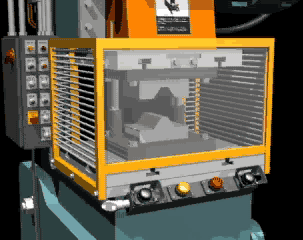Machine Guarding eTool
Presses » Barrier Guards
Barrier Guards are appropriate safeguards for full revolution and part revolution mechanical power presses. They are designed to keep the operator's hands and arms from entering the "danger zone" as prescribed by the particular machine. Barrier guards are usually the first point-of-operation safeguard considered for machines.
-
Barrier guards on power presses must prevent the entry of hands or fingers into the point of operation by reaching through, over, under or around the guard. [29 CFR 1910.217(c)(2)(i)(a)]
-
The barrier guards must conform to maximum permissible openings tables. [29 CFR 1910.217(c)(2)(i)(b)]
-
The barrier guard itself must not create pinch points between the guard and moving machine parts. [29 CFR 1910.217(c)(2)(i)(c)]
-
The guard must not be easily removable. [29 CFR 1910.217(c)(2)(i)(d)]
-
The guard must not interfere with machine inspection. [29 CFR 1910.217(c)(2)(i)(e)]
-
The barrier guard must offer maximum visibility of the point of operation consistent with the other requirements. [29 CFR 1910.217(c)(2)(i)(f)]

- Die enclosure guard
-
Must be attached to the die shoe or stripper in a fixed position. [29 CFR 1910.217(c)(2)(ii)]
-
- Fixed barrier guard
-
Must be attached securely to the frame of the press or to the bolster plate. [29 CFR 1910.217(c)(2)(iii)]
-
- Interlocked press barrier guard
-
Must be attached to the press frame or bolster and be interlocked with the press clutch so the clutch can not be activated unless the guard itself, or the hinged or moveable sections of the guard conform to listed requirements. [29 CFR 1910.217(c)(2)(iv)]
-
The hinged or movable sections of an interlocked press barrier guard must not be used for manual feeding. [29 CFR 1910.217(c)(2)(v)]
-
The guard must prevent opening of the interlocked section and reaching into the point of operation prior to die closure or before the slide stops. [29 CFR 1910.217(c)(2)(v)]
-
- Adjustable barrier guard
-
Must be securely attached to the press bed, bolster plate, or die shoe, and shall be adjusted and operated in conformity with Table O-10. [29 CFR 1910.217(c)(2)(vi)]
-



 Click on image to view animation
Click on image to view animation 